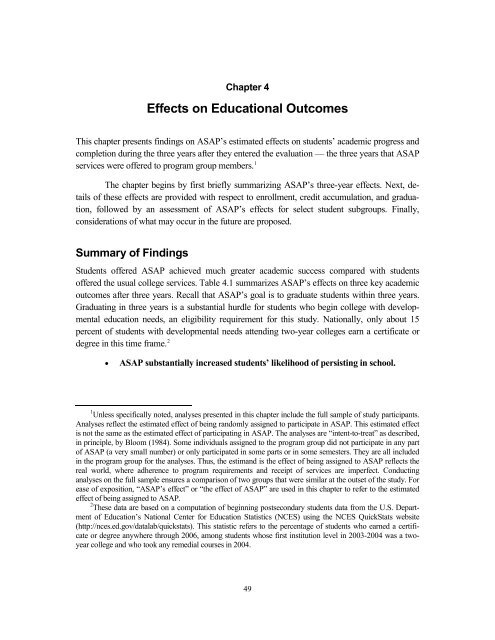1dOprzL
1dOprzL
1dOprzL
Create successful ePaper yourself
Turn your PDF publications into a flip-book with our unique Google optimized e-Paper software.
Chapter 4Effects on Educational OutcomesThis chapter presents findings on ASAP’s estimated effects on students’ academic progress andcompletion during the three years after they entered the evaluation — the three years that ASAPservices were offered to program group members. 1The chapter begins by first briefly summarizing ASAP’s three-year effects. Next, detailsof these effects are provided with respect to enrollment, credit accumulation, and graduation,followed by an assessment of ASAP’s effects for select student subgroups. Finally,considerations of what may occur in the future are proposed.Summary of FindingsStudents offered ASAP achieved much greater academic success compared with studentsoffered the usual college services. Table 4.1 summarizes ASAP’s effects on three key academicoutcomes after three years. Recall that ASAP’s goal is to graduate students within three years.Graduating in three years is a substantial hurdle for students who begin college with developmentaleducation needs, an eligibility requirement for this study. Nationally, only about 15percent of students with developmental needs attending two-year colleges earn a certificate ordegree in this time frame. 2• ASAP substantially increased students’ likelihood of persisting in school.1 Unless specifically noted, analyses presented in this chapter include the full sample of study participants.Analyses reflect the estimated effect of being randomly assigned to participate in ASAP. This estimated effectis not the same as the estimated effect of participating in ASAP. The analyses are “intent-to-treat” as described,in principle, by Bloom (1984). Some individuals assigned to the program group did not participate in any partof ASAP (a very small number) or only participated in some parts or in some semesters. They are all includedin the program group for the analyses. Thus, the estimand is the effect of being assigned to ASAP reflects thereal world, where adherence to program requirements and receipt of services are imperfect. Conductinganalyses on the full sample ensures a comparison of two groups that were similar at the outset of the study. Forease of exposition, “ASAP’s effect” or “the effect of ASAP” are used in this chapter to refer to the estimatedeffect of being assigned to ASAP.2 These data are based on a computation of beginning postsecondary students data from the U.S. Departmentof Education’s National Center for Education Statistics (NCES) using the NCES QuickStats website(http://nces.ed.gov/datalab/quickstats). This statistic refers to the percentage of students who earned a certificateor degree anywhere through 2006, among students whose first institution level in 2003-2004 was a twoyearcollege and who took any remedial courses in 2004.49


